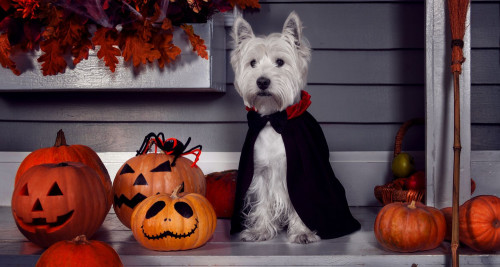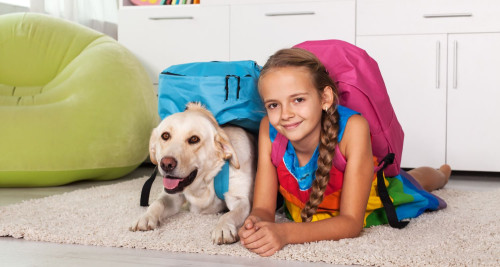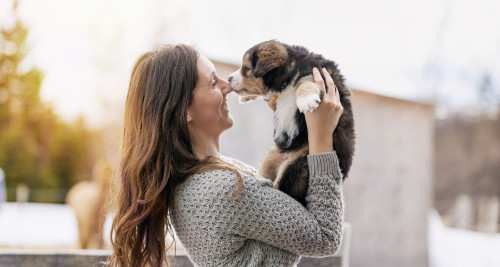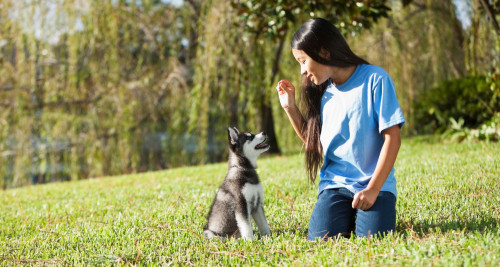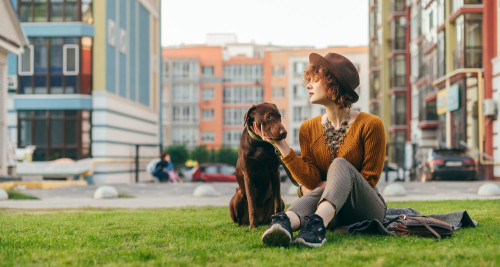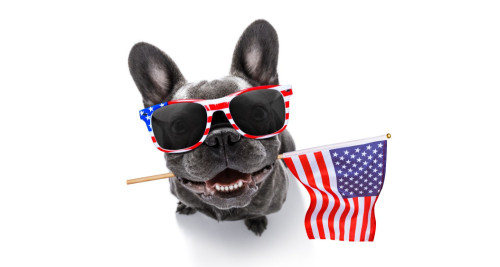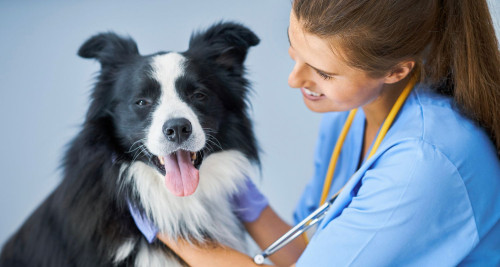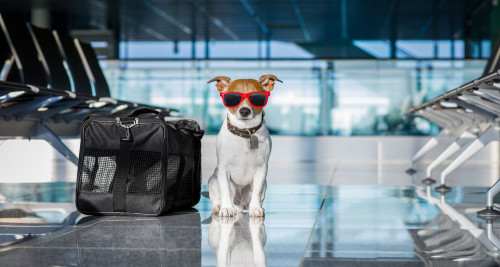Siberian Husky
Breed Traits and Characteristics
According to the American Kennel Club, here are some breed characteristic you can find in Siberian Huskies.
- Height
21-23.5 inches (male), 20-22 inches (female)
- Weight
45-60 pounds (male), 35-50 pounds (female)
- Life Expectancy
12-14 years
- Coat Type/Length
Double/Medium
-
100 Affectionate with Family
-
100 Good with Young Children
-
100 Good with Other Dogs
-
60 Trainability Level
-
100 Energy Level
-
100 Barking Level
-
80 Shedding Level
-
20 Drooling Level
History
Siberian Husky were used by the Chukchi Eskimos of Northeastern Asia to haul long distance loads over rough terrain. The Chukchis lived inland and needed to get to the sea to hunt and be able to haul back a sled full of walrus meat. Huskies were ideal sled dogs. They were also known for herding reindeer.
They arrived in the United States and Canada in 1909 via Alaska during the Nome Gold Rush to help with transportation and compete in races. Originally named the Alaskan Husky, their name was changed to the Siberian Husky as a salute to their originating country -- Siberia, Russia.
Some historians believe the breed could be 27,000 years old, as suggested by DNA from the ancient bones of an Arctic Wolf.
The Husky is now ranked #12 in the American Kennel Club’s list of most popular breeds.
The Siberian Husky
A true hero of dog breeds, the Husky used to race across the rugged tundras of Alaska delivering life-saving medicine to remote areas. Today, this breed still glides gracefully across ice, and loves the cold!
The graceful, medium-sized Siberian Husky’s almond-shaped eyes can be either brown or blue—and sometimes one of each—and convey a keen but amiable and even mischievous expression. Quick and nimble-footed, Siberians are known for their powerful but seemingly effortless gait. Tipping the scales at no more than 60 pounds, they are noticeably smaller and lighter than their burly cousin, the Alaskan Malamute.
As born pack dogs, they enjoy family life and get on well with other dogs. The Sibe’s innate friendliness render them indifferent watch-dogs. These are energetic dogs who can’t resist chasing small animals, so secure running room is a must. An attractive feature of the breed: Sibes are naturally clean, with little doggy odor.”
Siberian Husky Personality & Temperament
If you are looking for a guard dog, a Husky would not be a good choice as they love people too much! They might tell you a stranger is lurking about, but they have no concept of protecting you. In fact, they may lick a burglar to death. Nor are they one-person dogs. However, if you want a dog that looks stunning, is outgoing, sensitive, mischievous, and great with children, the Husky is your breed!
Although Huskies can look intimidating and their Arctic temperament makes them determined and self-sufficient, they are extremely sensitive. They are the original Houdini dog and can dig under a fence faster than you can fill the holes, and over the fence quicker than you can catch them. In fact, the average fence won’t even stop them. They can leap over gates and escape from leashes and collars if not trained properly. Because of their wanderlust, they should be microchipped and identified with a tag at all times.
Huskies are highly intelligent but not needy. They are territorial but not aggressive. Be careful of cats and smaller pets because the prey instinct is ingrained in a Husky. They can be trained as great therapy dogs, as they are sensitive to a drop in blood sugar or the beginning of a seizure.
Socialization
Think of the “energizer bunny” and that’s a Husky! This breed wants to be by your side at all times. Huskies don’t like to be left alone, so pet parents need to be wary of separation anxiety. Huskies are not content to snooze by your side on the couch and want to be out and about among other people and dogs. If you’re thinking of leaving them outdoors by themselves for hours at a time, expect to come home with a crater in your yard!
They will get along well with other dogs but early socialization is important. Why? So your dog gets used to new people, things and places and doesn’t develop any fears that turn into phobias. Also, so they develop pleasant associations, such as going to the park is fun! It’s even important to take them to the vet early on so they aren’t frightened by the experience.
Siberian Husky Breed Facts
Physical Characteristics
The Siberian Husky, often called a Husky or Sibe, is a medium-size dog. They are less burly than their cousin the Alaskan Malamute and easier to train. The Husky has a wild, wolf-like appearance with a muscular body. You may often see a white and black or red and white pattern on its head. The ears are shaped like triangles and eyes can be either a gorgeous blue and brown or a combination of each. Their small ears are designed to maintain body heat, unlike the large ears of the Chihuahua, which are designed for cooling.
Huskies like to dig! A Husky’s feet often function as snow shoes and the hair between their toes keep their paws toasty. Their claws make it easier to dig through ice and snow and burrow themselves into a hole to stay warm. Huskies can curl up in the snow to sleep and still survive.
The Husky tail points downward when they are relaxed and curls up when they are on the move. Their whiskers are especially sensitive which come in handy when they are hunting at night.
- Average Height: 21 to 23.5 inches (male); 20 to 22 inches (female)
- Average Weight: 45 to 60 pounds (male); 35 to 50 pounds (female)
- Average Life Expectancy: 12 years
Unique Breed Traits
Less known as sled dogs today, Huskies are great family pets and companions. With a great sense of humor, the Husky will keep you laughing with his antics. At the same time, their energy requires these dogs to be well exercised daily or there is a strong potential for digging and destructive behavior.
Unique Traits:
- Intelligent, affectionate, mischievous
- Great with kids
- Great with other dogs
- Happy-go-lucky and even-tempered
- Always on the go
- Innate desire to work
- Adapts easily to new environments
- Stubborn
Fun Facts
- The Disney movie “Eight Below” is based on the true story of the 1957 Japanese expedition to the South Pole and stars six Huskies.
- A statue of the Husky named Balto stands in Central Park, NY
- The color of a Husky’s nose reflects the color of his coat. If the dog is black, brown and gray, his nose is black. White dogs have a flesh-colored nose and copper dogs have a liver-colored nose.
- Huskies in colder climates shed less than Huskies in warmer climates.
- Husky howls can be heard up to 10 miles away – pet parents will swear they can “talk”.
- The indigenous Chukchi people used Huskies versus nannies to watch their children.
- Huskies have a “snow nose” which appears is winter and goes away in the summer.
- When they sleep their tails touch their noses – known as “the Swirl.”
- Many universities – such as the University of Washington and Northeastern University have the Husky as a mascot.
- In the story of The Husky, there will be no appendix, as this bred doesn’t have one!
- Huskies have been banned from Antarctica since 1994 due to fears they could bring canine distemper to the seal population.
Siberian Husky Common Behavioral Issues
A Husky may not be the best choice for a first-time pet parent. The phrase “obedient Siberian Husky” is something of an oxymoron. Too many Huskies end up in shelters because pet parents choose them for their classic looks and aren’t ready for their challenging nature. Sometimes referred to as “canine divas,” Huskies will often ignore your commands unless you learn to speak their language.
The Husky typically doesn’t respond well to punishment or treats. Instead, you must establish yourself as the “Top Dog” and communicate using voice tones and body language. This is how Bark Busters produces such awesome training results – we “speak dog.” Bark Busters trainers love working with Huskies as they are highly intelligent and loving, if you understand their needs.
One of the behavioral issues we encounter with this breed is ‘escaping’ - they won’t stick around if they see an opportunity to bolt. This stems from their need to belong to a strong pack. As a pet parent, if you don’t provide leadership, they might look elsewhere.
Also, Huskies can have barking and howling issues, although they howl more than bark thanks to inherited wolf howling behavior. It’s not enough to know that a dog barks or howls, it’s important to know why!
Huskies are not as people pleasing as some other breeds and can be known for the following mis-behaviors:
- Escaping
- Chewing, mouthing, and digging
- Destroying when bored
- Howling
- Difficulty house training, requiring consistency and patience
Adult Huskies can be rambunctious and their puppies are even more high maintenance. Huskies need the equivalent of three to five miles of exercise four to five times a week. Exercise will help your husky maintain strong and healthy bones, a healthy heart, and proper growth. Don’t forget that the best exercise of all is ‘mental exercise’ so find ways to stretch your Huskies intellect daily - simple training exercises can do the trick!
Connect with Us!
Need help training your Siberian Husky? Call 1-877-500-BARK (2275)or enter your zip code.
Bark Busters Trainer Jeff Drier on the Siberian Husky
Siberian Huskies are fascinating dogs on many levels. Although dogs have been domesticated for thousands of years, they do retain some of their wild ancestors’ characteristics and Huskies probably more than most. They have even retained very wolf-like looks although their gentle eyes will give them away.
Like wolves, Huskies have a very strong pack drive and many of the Husky owners we’ve worked with have multiple Huskies. This pack drive makes them have a strong need to be included in activities. It also means that the people they live with need to understand and practice pack leadership because if they don’t, their dogs will take over and run things their way, which rarely aligns with human thinking. Luckily understanding and practicing leadership is not a physical endeavor but involves understanding canine psychology and communication.
You may have heard a Husky pet parent state that their dog can “talk.” They will readily “voice” their opinions on everything with loud yips and howls. But they are not typically nuisance barkers. They are also not typically very good “watch dogs.” Their social nature can make them friendly to everyone, yet they feel very territorial if they perceive a threat. It’s that pack mentality again coming into play.
Like wolves, Huskies are athletes. If you are a marathoner, you won’t go wrong if you get a Husky to run with, although some of these dogs will think the marathon is just the warm-up! These dogs can run all day while pulling many times their own weight. As with human athletes, they need more than physical exercise – they need mental exercise as well. They also love to pull, so teaching them to walk with you and not drag you can be a challenge. Remember they are “mushers” at heart.
Huskies are smart dogs and love learning but once they learn something, unless they view you as the pack leader, they may not do what you ask them to do. They can be stubborn and frustrating in that regard, so patience and determination will be required. Be creative in finding things that hold their interest, other than just running, which is their first love. Speaking of running, if there are young children around who leave the doors open, a Husky will escape and take off sprinting. Did I mention that Huskies love to run?
Huskies are definitely not the breed for people with allergies, because no matter how much you brush them, dust bunnies will fly about. You will also need a bucket or towel by the door.
Huskies, like wolves, burrow. They will dig holes, mainly to curl up in. Their relatives in cold climates do that to maintain their warmth and even in Florida, they will dig holes when left outside without supervision. Expect worn paths where they run in the yard and holes where they curl up to rest. If you are an avid gardener, expect help from your Husky although it might not be the kind of help you want.
We are often consulted by Siberian Husky Rescue in Florida regarding helping some of the more troublesome dogs in their wonderful care. Their close relation to their wild cousins can make them challenging to make part of your family. Often these troublemakers are really seeking leadership. If they don’t find it in the humans they live with, they do try to take that role on themselves.
Understanding the dynamics of the pack is crucial to having calm, happy Huskies. They are wonderful dogs, but they are not for everyone. Bark Busters’ trainers can help you understand these wonderful dogs and teach you how to become the leader of your pack without drama. It is well worth the effort.
Games to Play with Your Husky
Running at speeds of up to 28 mph, it’s hard to get a Husky to slow down. In fact, if you love to bike or jog, a Husky would make a great sidekick especially for going long distances.
Since most of us don’t live in the tundra, many Huskies still enjoy “urban sledding.” Urban sledding is a form of mushing and may involve one or more dogs. Activities include carting, sled dog racing, scootering, biking, canicross, pulka, freighting, weight pulling, and other activities. Originally developed to keep sled dogs in shape during the off season, dryland sledding is growing in popularity.
Walking Your Husky Correctly
As we said earlier, Huskies have been bred to be sled dogs and “pull” things. This does not work out so well for pet parents on a walk. Huskies love to roam, so it is best to always walk yours on a leash or you’ll tune your head and they’ll be chasing a squirrel or rabbit.
Siberian Husky Grooming
Huskies are double-coated with a top coat that is straight and a bottom coat that is thick. They shed year-round so they need to be brushed weekly. In Spring and Fall, their undercoat sheds known as “blowing their coat.” A lint brush, coat rake, and vacuum are must-haves if you own a Husky! Fastidiously clean and with little body odor, their coat can keep them warm in temperatures as low as negative 50 degrees. Yikes!
Huskies have great teeth, so if you brush them twice a week your Husky will have pearly whites.
Tips for Every Dog Owner
Hear from Bark Busters Clients Who Have a Siberian Husky
Need Dog Training Assistance with your Husky? Find Your Local Trainer Now!
CALL TODAY 1-877-500-BARK (2275)
